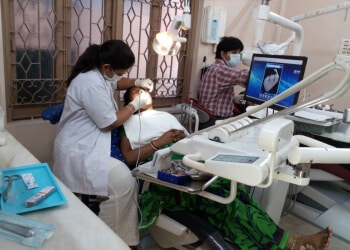Dental technology has experienced a remarkable transformation in recent years, significantly enhancing patient care and outcomes. Advances in this field are driven by the convergence of digital technology, innovative materials, and refined techniques, all contributing to a more efficient, effective, and comfortable dental experience. The integration of these technologies into dental practice represents a paradigm shift, with a strong emphasis on precision, patient comfort, and overall treatment efficacy. One of the most notable advancements is the advent of digital imaging. Traditional X-rays have largely been replaced by digital radiography, which offers superior image quality with lower radiation exposure. This technology allows for instant image capture and analysis, providing detailed views of the teeth and surrounding structures. Dentists can use these images to make more accurate diagnoses and create comprehensive treatment plans. Additionally, 3D imaging technology, including cone beam computed tomography CBCT, has revolutionized the way dentists view and analyze oral anatomy. This technology enables precise visualization of bone structures, aiding in complex procedures such as implant placement and orthodontic planning.
 In addition to imaging advancements, the development of intraoral scanners has transformed the way dental impressions are taken. Traditionally, impression molds were made using messy and uncomfortable materials. Today, intraoral scanners capture high-resolution, digital impressions of the teeth and gums with remarkable accuracy and comfort. These digital impressions are used to create detailed models for restorative work, such as crowns, bridges, and aligners. The elimination of physical molds not only enhances patient comfort but also improves the precision of dental restorations. The field of restorative dentistry has also benefited from technological advances. CAD/CAM Computer-Aided Design and Computer-Aided Manufacturing systems allow for the design and fabrication of dental restorations in a single visit. The dentist can design crowns, veneers, and other restorations using sophisticated software and then mill them on-site with precise machinery. This technology significantly reduces the time required for patients to receive their restorations and enhances the fit and longevity of the final product. Another groundbreaking development is the use of laser technology in various dental procedures. Lasers offer a minimally invasive alternative to traditional methods, reducing the need for anesthesia and minimizing discomfort during treatments.
In addition to imaging advancements, the development of intraoral scanners has transformed the way dental impressions are taken. Traditionally, impression molds were made using messy and uncomfortable materials. Today, intraoral scanners capture high-resolution, digital impressions of the teeth and gums with remarkable accuracy and comfort. These digital impressions are used to create detailed models for restorative work, such as crowns, bridges, and aligners. The elimination of physical molds not only enhances patient comfort but also improves the precision of dental restorations. The field of restorative dentistry has also benefited from technological advances. CAD/CAM Computer-Aided Design and Computer-Aided Manufacturing systems allow for the design and fabrication of dental restorations in a single visit. The dentist can design crowns, veneers, and other restorations using sophisticated software and then mill them on-site with precise machinery. This technology significantly reduces the time required for patients to receive their restorations and enhances the fit and longevity of the final product. Another groundbreaking development is the use of laser technology in various dental procedures. Lasers offer a minimally invasive alternative to traditional methods, reducing the need for anesthesia and minimizing discomfort during treatments.
Laser technology is used in a wide range of applications, including cavity preparation, gum reshaping, and teeth whitening. The precision of lasers allows for more targeted treatment, resulting in quicker recovery times and improved outcomes. The incorporation of artificial intelligence AI into dental practice is also on the rise. AI-driven diagnostic tools and treatment planning software can analyze large volumes of data to assist dentists in identifying patterns and making informed decisions. These tools can enhance diagnostic accuracy, predict treatment outcomes, and optimize patient care. Overall, the latest advances in dental technology reflect a commitment to improving patient experiences and outcomes. By leveraging digital imaging, intraoral scanning, CAD/CAM systems, laser technology, and AI, dental professionals are equipped to provide higher-quality care with greater efficiency. As these technologies continue to evolve, patients can expect even more innovative solutions that prioritize comfort, precision, and effective treatment. The future of dentistry promises an exciting array of possibilities, all aimed at enhancing oral health and overall well-being.
